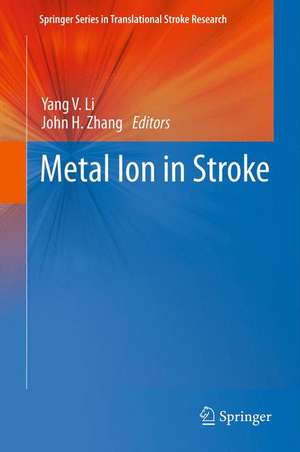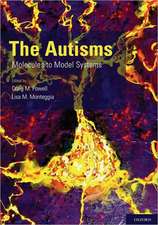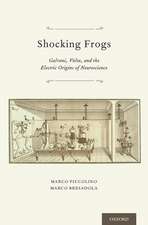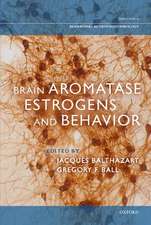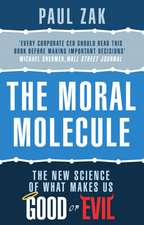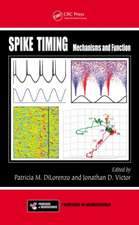Metal Ion in Stroke: Springer Series in Translational Stroke Research
Editat de Yang V. Li, John H. Zhangen Limba Engleză Hardback – 17 mai 2012
| Toate formatele și edițiile | Preț | Express |
|---|---|---|
| Paperback (1) | 1242.35 lei 43-57 zile | |
| Springer – 23 aug 2016 | 1242.35 lei 43-57 zile | |
| Hardback (1) | 1248.02 lei 43-57 zile | |
| Springer – 17 mai 2012 | 1248.02 lei 43-57 zile |
Preț: 1248.02 lei
Preț vechi: 1521.98 lei
-18% Nou
Puncte Express: 1872
Preț estimativ în valută:
238.81€ • 249.97$ • 198.76£
238.81€ • 249.97$ • 198.76£
Carte tipărită la comandă
Livrare economică 31 martie-14 aprilie
Preluare comenzi: 021 569.72.76
Specificații
ISBN-13: 9781441996626
ISBN-10: 1441996621
Pagini: 626
Ilustrații: XVII, 820 p.
Dimensiuni: 155 x 235 x 48 mm
Greutate: 1.32 kg
Ediția:2012
Editura: Springer
Colecția Springer
Seria Springer Series in Translational Stroke Research
Locul publicării:New York, NY, United States
ISBN-10: 1441996621
Pagini: 626
Ilustrații: XVII, 820 p.
Dimensiuni: 155 x 235 x 48 mm
Greutate: 1.32 kg
Ediția:2012
Editura: Springer
Colecția Springer
Seria Springer Series in Translational Stroke Research
Locul publicării:New York, NY, United States
Public țintă
GraduateCuprins
Preface.- Metal Ions In Stroke Pathophysiology.- Mechanisms Of Calcium Influx Following Stroke.- Mitochondrial Ca2+ Dysregulation During Stroke And Cell Death.- Calcium Channel Blockers And Stroke Prevention.- Calcium Dyshomeostasis In Astrocytes After Ischemia.- Calcium Signaling At The Blood-Brain Barrier In Stroke.- Zinc Overload In Stroke.- Intracellular Zinc Liberation: A Trigger For Oxidative Stress Induced Toxicity To Neurons And Neuroglia.- Zinc In Stroke: Time For A New Approach?.- Exploring The Zinc Metallome Of Cultured Cortical Neurons Using Synchroton Radiation X-Ray Fluorescence Microscopy.- Iron Neurotoxicity In Ischemic And Hemorrhagic Stroke.- Implication Of Oxidative Stress And “Labile Iron” In The Molecular Mechanisms Of Ischemic Stroke.- The Role Of Iron In Brain Following Subarachnoid Hemorrhage.- Iron Chelating Therapy In Stroke.- Iron Chelating Therapy In Stroke.- The Role Of Na+/Ca2+ Countertransport And Other Na+-Entry Routes In The Pathophysiology Of Stroke.- Sodium And Potassium MRI In Cerebral Ischemia.- The Impact Of Extracellular Potassium Accumulation In Stroke.- Potassium And Mitochondria.- Role Of A Changing Membrane Potential (Em) And Matching Blood Flow With Neuronal Activity.- The Role Of Potassium In Stroke, Cardiovascular Disease And Hypertension.- The Role Of Magnesium In The Pathophysiology And Treatment Of Stroke And Other Neurological Injuries.- The Role Of Magnesium In The Pathophysiology And Treatment Of Stroke And Other Neurological Injuries.- Magnesium And Neuroprotection In Stroke.- Magnesium In Ischemic Stroke And Subarachnoid Hemorrhage.- Selenium And Selenoproteins In Neuroprotection And Neuronal Cell Death.- Selenium As A Potential Treatment In Cardiac Arrest Induced Global Cerebral Ischemia.- The Neurochemical Alterations Associated With Manganese Toxicity.- Manganese Speciation Related To Neurotoxicity In Humans.- The Role Of Mitochondrial OxidativeStress And ATP Depletion In The Pathology Of Manganese Toxicity.- Copper And Alzheimer Disease: The Good, The Bad And The Ugly.- Conjecturable Role Of Aluminum In Pathophysiology Of Stroke.- Chronic Arsenic Poisoning And Increased Risk Of Stroke.- Aspects Of Cadmium Neurotoxicity.- Cadmium Neurotoxicity And Its Role In Brain Disorders.- The Role Of Mercury And Cadmium In Cardiovascular Disease, Hypertension, And Stroke.- Nickel Modulation Of Voltage- And Ligand-Gated Ionic Channels In Neurons.
Recenzii
From the reviews:
“This is a comprehensive book about the role of ions and anions in neurotransmission, cerebral ischemia, subarachnoid hemorrhage, trauma etc. Each chapter is devoted to the indication of mediators related to channel and mitochondrial pathophysiology. … I recommend this book to neurologists, neurosurgeons, biochemists, and neurophysiologists. Students will be greatly helped by this book, showing that cofactors can be toxic, but at micromolar ranges be beneficial to the stroked brain in small vessel disease.” (Joseph J. Grenier, Amazon.com, May, 2014)
“This is a comprehensive book about the role of ions and anions in neurotransmission, cerebral ischemia, subarachnoid hemorrhage, trauma etc. Each chapter is devoted to the indication of mediators related to channel and mitochondrial pathophysiology. … I recommend this book to neurologists, neurosurgeons, biochemists, and neurophysiologists. Students will be greatly helped by this book, showing that cofactors can be toxic, but at micromolar ranges be beneficial to the stroked brain in small vessel disease.” (Joseph J. Grenier, Amazon.com, May, 2014)
Textul de pe ultima copertă
This book illustrates remarkable roles of metal ions in the neuropathophysiology of stroke, which is a major cause of death and disability worldwide. Metal ions have unique chemical properties that allow them to play diverse roles in the brain. They regulate excitability and function as co-factors in cellular and genetic signaling pathways and therefore, have important roles ranging from essential to toxic. For the first time, the dyshomeostasis and pathophysiological actions of these metals in stroke are discussed systematically in thirty-six chapters in one volume.
Highlighted metal ions include:
Aluminum (Al)
Arsenic (As)
Cadmium (Cd)
Calcium (Ca)
Copper (Cu)
Iron (Fe)
Magnesium (Mg)
Manganese (Mn)
Mercury (Hg)
Nickel (Ni)
Potassium (K)
Selenium (Se)
Sodium (Na)
Zinc (Zn)
Highlighted metal ions include:
Aluminum (Al)
Arsenic (As)
Cadmium (Cd)
Calcium (Ca)
Copper (Cu)
Iron (Fe)
Magnesium (Mg)
Manganese (Mn)
Mercury (Hg)
Nickel (Ni)
Potassium (K)
Selenium (Se)
Sodium (Na)
Zinc (Zn)
Caracteristici
Details the cellular events that occur following stroke For the first time, the dyshomeostasis and pathophysiological actions of these metals in stroke are discussed systematically in one volume. Many metals function as co-factors in cellular and genetic signaling and, therefore, have important roles in biochemistry ranging from essential to toxic
